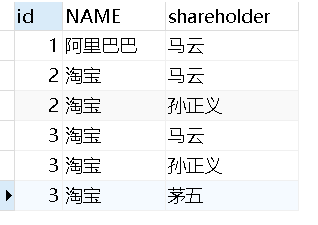原始数据

处理结果展示

DDL
CREATE TABLE `company` ( `id` int(20) DEFAULT NULL, `name` varchar(100) DEFAULT NULL, `shareholder` varchar(100) DEFAULT NULL ) ENGINE=InnoDB DEFAULT CHARSET=utf8;
DML
INSERT INTO `company` VALUES ('1', '阿里巴巴', '马云'); INSERT INTO `company` VALUES ('2', '淘宝', '马云,孙正义'); INSERT INTO `company` VALUES ('2', '淘宝', '马云,孙正义,茅五');
三种方式,相同的原理
1.使用MySQL库中的自增序列表
SELECT a.id, a. NAME, substring_index( substring_index( a.shareholder, ',', b.help_topic_id + 1 ), ',' ,- 1 ) AS shareholder FROM company a JOIN mysql.help_topic b ON b.help_topic_id < ( length(a.shareholder) - length( REPLACE (a.shareholder, ',', '') ) + 1 )
2.自建自增序列表
CREATE TABLE `addself` ( `id` int(20) DEFAULT NULL ) ENGINE=InnoDB DEFAULT CHARSET=utf8;
INSERT INTO `addself` VALUES ('0'); INSERT INTO `addself` VALUES ('1'); INSERT INTO `addself` VALUES ('2'); INSERT INTO `addself` VALUES ('3'); INSERT INTO `addself` VALUES ('4');
SELECT a.id, a.NAME, substring_index( substring_index( a.shareholder, ',', b.id+ 1 ), ',' ,- 1 ) AS shareholder FROM company a JOIN addself b ON b.id< ( length(a.shareholder) - length( REPLACE (a.shareholder, ',', '') ) + 1 )
3.以数据库里已有表,构建自增序列表
select a.ID,a.name,substring_index(substring_index(a.shareholder,',',b.id+1),',',-1) shareholder from company a join (SELECT (@ROW :=@Row + 1) as id FROM xh,(SELECT @Row:=-1) zz) b on b.id < (length(a.shareholder) - length(replace(a.shareholder,',',''))+1);